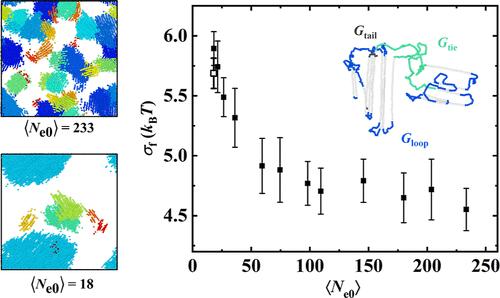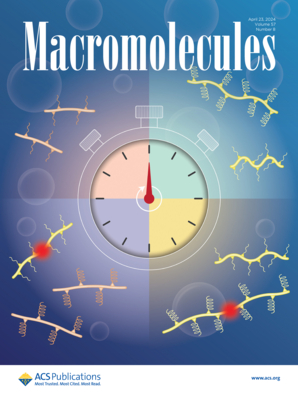Role of Entanglement in Polymer Crystal Growth and Melting: Molecular Dynamics Simulations
IF 5.1
1区 化学
Q1 POLYMER SCIENCE
引用次数: 0
Abstract
The influence of entanglement on the growth and melting of polymer crystals is investigated by using molecular dynamics simulations across systems with different entanglement densities. Reducing entanglement density leads to a slight decrease of crystal thickness L but an increase of melting temperature Tm. To elucidate the entanglement-related inverse relation between Tm and L, we introduce the fold surface free energy σf predominantly governed by the conformational entropy loss of amorphous segments. Reducing the entanglement density results in a decrease of σf. Combining the contributions of σf and L, a linear relation between Tm and σf/L is obtained, which is consistent with the prediction of the Gibbs–Thompson equation. Crystallization commonly accompanies with disentanglement, while crystal melting precedes before entanglement reconstruction. Considering the thermodynamic contribution of entanglement, polymer crystallization and melting are not two mutually reversible phase transitions, not only kinetically but also thermodynamically.

纠缠在聚合物晶体生长和熔化中的作用:分子动力学模拟
通过对不同纠缠密度的系统进行分子动力学模拟,研究了纠缠对聚合物晶体生长和熔化的影响。降低纠缠密度会导致晶体厚度 L 略微减小,但熔化温度 Tm 会升高。为了阐明 Tm 与 L 之间与纠缠相关的反比关系,我们引入了主要受非晶段构象熵损失支配的折叠表面自由能 σf。降低纠缠密度会导致 σf 下降。结合 σf 和 L 的贡献,可以得到 Tm 与 σf/L 之间的线性关系,这与吉布斯-汤普森方程的预测一致。结晶通常伴随着解纠缠,而晶体熔化则先于纠缠重建。考虑到纠缠的热力学贡献,聚合物结晶和熔化不仅在动力学上而且在热力学上都不是两个相互可逆的相变。
本文章由计算机程序翻译,如有差异,请以英文原文为准。
求助全文
约1分钟内获得全文
求助全文
来源期刊

Macromolecules
工程技术-高分子科学
CiteScore
9.30
自引率
16.40%
发文量
942
审稿时长
2 months
期刊介绍:
Macromolecules publishes original, fundamental, and impactful research on all aspects of polymer science. Topics of interest include synthesis (e.g., controlled polymerizations, polymerization catalysis, post polymerization modification, new monomer structures and polymer architectures, and polymerization mechanisms/kinetics analysis); phase behavior, thermodynamics, dynamic, and ordering/disordering phenomena (e.g., self-assembly, gelation, crystallization, solution/melt/solid-state characteristics); structure and properties (e.g., mechanical and rheological properties, surface/interfacial characteristics, electronic and transport properties); new state of the art characterization (e.g., spectroscopy, scattering, microscopy, rheology), simulation (e.g., Monte Carlo, molecular dynamics, multi-scale/coarse-grained modeling), and theoretical methods. Renewable/sustainable polymers, polymer networks, responsive polymers, electro-, magneto- and opto-active macromolecules, inorganic polymers, charge-transporting polymers (ion-containing, semiconducting, and conducting), nanostructured polymers, and polymer composites are also of interest. Typical papers published in Macromolecules showcase important and innovative concepts, experimental methods/observations, and theoretical/computational approaches that demonstrate a fundamental advance in the understanding of polymers.
 求助内容:
求助内容: 应助结果提醒方式:
应助结果提醒方式:


